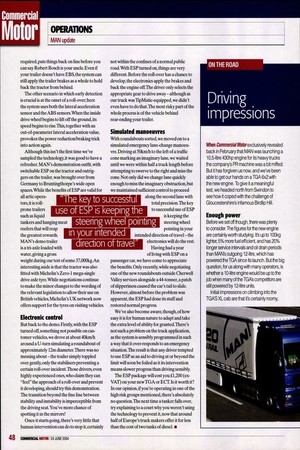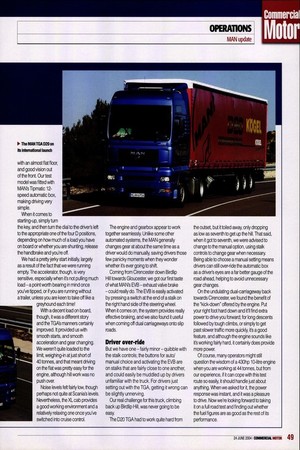!Driving . impressions
Page 50

Page 51

If you've noticed an error in this article please click here to report it so we can fix it.
When Commercial Motor exclusively revealed back in February that MAN was launching a 10.5-litre 430hp engine for its heavy trucks the company's PR machine was a bit miffed. But it has forgiven us now, and we've been able to get our hands on a TGA 6x2 with the new engine. To give it a meaningful test, we headed north from Swindon to see how it coped with the challenge of Gloucestershire's infamous Birdlip Hill. Enough power
Before we set off though, there was plenty to consider. The figures for the new engine are certainly worth studying. It's up to 100kg lighter, 5% more fuel efficient, and has 20% longer service intervals and oil drain periods than MAN's outgoing 12-litre, which has powered the TGA since its launch. But the big question, for us along with many operators, is whether a 10-litre engine would be up to the job when many of the TGAs competitors are still powered by 12-litre units. Initial impressions on climbing into the TGA'S XL cab are that it's certainly roomy,
with an almost flat floor, and good vision out of the front. Our test model was fitted with MAN'S Tipmatic 12speed automatic box, making driving very simple.
When it comes to starting-up, simply turn the key, and then turn the dial to the driver's left to the appropriate one of the four D positions, depending on how much of a load you have on board or whether you are shunting, release the handbrake and you're off.
When it comes to starting-up, simply turn the key, and then turn the dial to the driver's left to the appropriate one of the four D positions, depending on how much of a load you have on board or whether you are shunting, release the handbrake and you're off. We had a pretty jerky start initially, largely as a result of the fact that we were running empty. The accelerator, though, is very sensitive, especially when it's not pulling much load —a point worth bearing in mind once you've tipped, or if you are running without a trailer, unless you are keen to take off like a
greyhound each time!
With a decent load on board, though, it was a different story and the TGA's manners certainly improved. It provided us with smooth starts, and smooth acceleration and gear changing. We weren't quite loaded to the limit, weighing-in at just short of 40 tonnes, and that meant driving on the flat was pretty easy for the engine, although hill work was no pushover. Noise levels felt fairly low, though perhaps not quite at Scania's levels. Nevertheless, the XL cab provides a good working environment and a relatively relaxing one once you've
switched into cruise control.
The engine and gearbox appear to work together seamlessly. Unlike some other automated systems, the MAN generally changes gear at about the same time as a driver would do manually, saving drivers those few panicky moments when they wonder whether it's ever going to shift.
Coming from Cirencester down Birdlip Hill towards Gloucester, we got our first taste of what MAN 's EVB — exhaust valve brake — could really do. The EVB is easily activated by pressing a switch at the end of a stalk on the right hand side of the steering wheel. When it comes on, the system provides really effective braking, and we also found it useful when coming off dual carriageways onto slip roads. Driver over-ride
But we have one—fairly minor — quibble with the stalk controls; the buttons for auto/ manual choice and activating the EVB are on stalks that are fairly close to one another, and could easily be muddled up by drivers unfamiliar with the truck. For drivers just setting out with the TGA, getting it wrong can be slightly unnerving.
Our real challenge for this truck, climbing back up Birdlip Hill, was never going to be easy. The D20 TGA had to work quite hard from
the outset, but it toiled away, only dropping as low as seventh to get up the hill. That said, when it got to seventh, we were advised to change to the manual option, using stalk controls to change gear when necessary. Being able to choose a manual setting means drivers can still over-ride the automatic box as a driver's eyes are a far better gauge of the road ahead, helping to avoid unnecessary gear changes.
On the undulating dual-carriageway back towards Cirencester, we found the benefit of the "kick-down" offered by the engine. Put your right foot hard down and it'll find extra power to drive you forward; for long descents followed by tough climbs, or simply to get past slower traffic more quickly, it's a good feature, and although the engine sounds like it's working fairly hard, it certainly does provide more power.
Of course, many operators might still question the wisdom of a 430hp 10-litre engine when you are working at 44 tonnes, but from our experience, if it can cope with this test route so easily, it should handle just about anything. When we asked for it, the power response was instant, and it was a pleasure to drive. Now we're looking forward to taking it on a full road test and finding out whether the fuel figures are as good as the rest of its performance.


































































































































































































